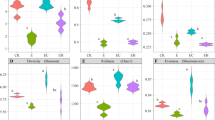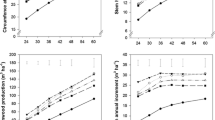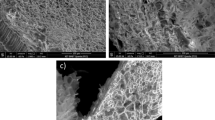Abstract
This study aimed to test the effect of Eucalyptus litter on growth, roots symbioses status and nutrition of Sahelian acacia’s seedlings. Sangalkam sandy soil was amended with two levels (1 and 5 %) of Eucalyptus litter. As control of the effect of litter addition, sandy soil was amended with 1 and 5 % of maize litter. In addition, a control without amendment was established to highlight any changes caused by amendments. Eucalyptus litter impact on A. senegal, A. seyal and A. albida was determined by comparing plants grown in amended treatments to plants grown in both control treatments. Results indicated that Eucalyptus litter leads to changes in soil pH and phenol content. These changes negatively affect plant growth, their symbiotic status (mycorrhization, nodulation), and their nutrition (leaf chlorophyll content, total carbon, total nitrogen and phosphorus in shoots). Likewise, soil enzymatic activities were modified. Acid phosphatase was higher in Eucalyptus litter amended soil than in control while alkaline phosphatase was higher in control soil than in Eucalyptus litter amended soil. Positive correlations were recorded between roots symbioses and shoots mineral content suggesting that arbuscular mycorrhizal fungus and N-fixing symbiosis promote mineral uptake and storage in leaves. However, polyphenolic content of added litter was negatively linked to roots symbioses and growth of tested acacias. Results showed also, Eucalyptus litter impact on acacias growth was genotype and dose dependent.

Similar content being viewed by others
References
Arnon DL (1949) A copper enzyme is isolated chloroplast polyphenol oxydase in beta vulgaries. Plant Physiol 24:1–15
Bardgett RD, Frankland JC, Whittaker JB (1993) The effects of agricultural practices on the soil biota of some upland grassland. Agr Ecosyst Environ 45:2–45
Bernhard-Reversat F (1999) The leaching of Eucalyptus hybrids and Acacia auriculiformis leaf litter: laboratory experiments on early decomposition and ecological implications in congolese tree plantations. Appl Soil Ecol 12:25–261
Bernhard-Reversat F, Loumeto JJ (2002) The litter system in African forest tree plantations. In: Vikram Reddy M (ed) Management of tropical plantation forests and their soil litter system. Science Publishers, Inc. Enfield, NH, pp 11–39
Bernhard-Reversat F, Main G, Holl K, Loumeto J, Ngao J (2003) Fast disappearance of the water-soluble phenolic fraction in eucalypt leaf litter during laboratory and field experiments. Appl Soil Ecol 23:273–278
Brundrett M, Bougher N, Dell B (1996) Working with mycorrhizas in forestry and agriculture. ACIAR Monograph 32. Australian Center for International Agricultural Research, Canberra
Callaway RM, Aschehoug ET (2000) Invasive plants versus their new and old neighbors: a mechanism for exotic invasion. Science 290(5491):521–523. doi:10.1126/science.290.5491.521
Callaway RM, Ridenour WM (2004) Novel weapons: invasive success and the evolution of increased competitive ability. Front Ecol Environ 2:436–443
Chaudhry MS, Batool Z, Khan AG (2005) Preliminary assessment of plant community structure and arbuscular mycorrhizas in rangeland habitats of cholistan desert, Pakistan. Mycorrhiza 15(8):606–611
Clark RB, Zeto SK (1996) Growth and root colonization of mycorrhizal maize grown on acid and alkaline soil. Soil Biol Biochem 28:1505–1511. doi:10.1016/S0038-0717(96)00164-2
Cohen J (1988) Statistical power analysis for the behavioral sciences, 2nd edn. Lawrence Erlbaum Associates Inc, Hillsdale, NJ
Del Moral R, Muller CH (1970) The allelopathic effects of Eucalyptus camaldulensis. Am Midland Nature 83:254–282
Ehrenfeld JG (2003) Effects of exotic plant invasions on soil nutrient cycling processes. Ecosystems 6:503–523
Faye A, Krasova-Wade T, Thiao M, Thioulouse J, Neyra M, Prin Y, Galiana A, Ndoye I, Dreyfus B, Duponnois R (2009) Controlled ectomycorrhization of an exotic legume tree species Acacia holosericea affects the structure of root nodule bacteria community and their symbiotic effectiveness on Faidherbia albida, a native Sahelian Acacia. Soil Biol Biochem 41:1245–1252
Forrester DI, Bauhus JR, Cowie AL, Vanclay JK (2006) Mixed-species plantations of Eucalyptus with nitrogen-fixing trees: a review. For Ecol Manage 233:211–230
Forrester D, Vanclay J, Forrester R (2011) The balance between facilitation and competition in mixtures of Eucalyptus and acacia changes as stands develop. Oecol 166:265–272
Guo LB, Sims REH (1999) Litter decomposition and nutrient release via litter decomposition in New Zealand eucalypt short rotation forests. Agr Ecosyst Environ 75:133–140
Guo LB, Sims REH (2002) Eucalypt litter decomposition and nutrient release under a short rotation forest regime and effluent irrigation treatments in New Zealand, II: internal effects. Soil Biol Biochem 34:913–922
Harper JR, Balke NE (1981) Characterization of the inhibition of K+ absorption in oat roots by salicylic acid. Plant Physiol 68:1349–1353
Högberg MN, Högberg P, Myrold DD (2007) Is microbial community composition in boreal forest soils determined by pH, C-to-N ratio, the trees, or all three. Oecologia 150:590–601
John MK (1970) Colorimetric determination in soil and plant material with ascorbic acid. Soil Sci 68:171–177
Khan MS, Zaidi A, Musarrat J (eds) (2010) Microbes for legume improvement. Springer, Wien. doi:10.1007/978-3-211-99753-6_2
Kisa M, Sanon A, Thioulouse J, Assigbetse K, Sylla S, Spichiger R, Dieng L, Berthelin J, Prin Y, Galiana A, Lepage M, Duponnois R (2007) Arbuscularmycorrhizal symbiosis can counterbalance the negative infuence of the exotic tree species Eucalyptus camaldulensis on the structure and functioning of soil microbial communities in a Sahelian soil. FEMS Microbiol Ecol 62:32–44
Le Maire G, Nouvellon Y, Christina M, Ponzoni FJ, Gonçalves JLM, Bouillet JP, Laclau JP (2012) Tree and stand light use efficiencies over a full rotation of single- and mixed-species Eucalyptus grandis and Acacia mangium plantations. For Ecol Manage. doi:10.1016/j.foreco.2012.03.005
Phillips JM, Hayman DS (1970) Improved procedures for clearing roots and staining parasitic and vesicular–arbuscular mycorrhizal fungi for rapid assessment of infection. T Brit Mycol Soc 55:158–161
Piotrowski JS, Morford SL, Rillig MC (2008) Inhibition of colonization by a native arbuscular mycorrhizal fungal community via Populus trichocarpa litter, litter extract, and soluble phenolic compounds. Soil Biol Biochem 40:709–717
Reigosa MJ, Souto XC, González L (1999) Effect of phenolic compounds on the germination of six weeds species. Plant Growth Regul 28:83–88
Richards AE, Forrester DI, Bauhus J, Scherer-Lorenzen M (2010) The influence of mixed tree plantations on the nutrition of individual species: a review. Tree Physiol 30:1192–1208
Runge M, Rode MW (1991) Effects of soil acidity on plant associations. In: Ulrich B, Sumner ME (eds) Soil acidity. Springer, New York, pp 183–202
Rustad LE, Cronan CS (1989) Cycling of aluminum and nutrients in litterfall of a red spruce (Picea rubens Sarg.) stand in Maine. Can J For Res 19:18–23
Seneviratne G, Jayasinghearachchi HS (2003) Mycelial colonization by bradyrhizobia and azorhizobia. J Bioscience 28:243–247
Sicardi M, García-Préchac F, Frioni L (2004) Soil microbial indicators sensitive to land use conversion from pastures to commercial Eucalyptus grandis (Hill ex Maiden) plantations in Uruguay. Appl Soil Ecol 27:125–133
Singh BK, Walker A (2006) Microbial degradation of organophosphorus compounds. FEMS Microbiol Rev 30:428–471
Singh JS, Raghubanshi AS, Singh AS, Srivastava SC (1989) Microbial biomass acts as a source of plant nutrients in dry tropical forest and savanna. Nature 338:449–500
Singleton VL, Rossi JA (1965) Colorimetry of total phenolics with phosphomolybdic–phosphotungstic acid reagents. Am J Enol Vitic 16:144–158
Smith SE, Read DJ (2008) Mycorrhizal symbiosis, 3rd edn. Academic, London
Soumare A, Sall SN, Manga GA, Hafidi M, Ndoye I, Duponnois R (2012) Effect of Eucalyptus camaldulensis and Zea mays litter on development, production, mycorrhizal colonization and roots nodulation of Arachis hypogaea. AJB 11(93):15994–16002
Stankiewicz BA, Gresser MJ (1998) Inhibition of phosphatase and sulfatase by transition-state analogs. Biochem J 27:206–212
Tabatabai MA, Bremner JM (1969) Use of p-nitrophenyl phosphate for assay of phosphatase activity. Soil Biol Biochem 1:301–307
Van der Heijden MGA, Klironomos JN, Ursic M, Moutoglis P, Streitwolf-Engel R, Boller T, Wiemken A, Sanders IR (1998) Mycorrhizal fungal diversity determines plant biodiversity ecosystem variability and productivity. Nature 396:69–72
Van der Heijden MGA, Bakker R, Verwaal J, Scheublin TR, Rutten M, van Logtestijn RSP, Staehelin C (2006) Symbiotic bacteria as a determinant of plant community structure and plant productivity in dune grassland. FEMS Microbiol Ecol 56:178–187
Van der Heijden MGA, Bardgett RD, van Straalen NM (2008) The unseen majority: soil microbes as drivers of plant diversity and productivity in terrestrial ecosystems. Ecol Lett 11:296–310
Wacker TL, Safir GR, Stephens CT (1990) Effects of ferulic acid on Glomus fasciculatum and associated effects on phosphorus uptake and growth of asparagus (Asparagus officinalis L.). J Chem Ecol 16:901–909
Zhua HH, Yaob Q, Suna XT, Hu YL (2007) Colonization, ALP activity and plant growth promotion of native and exotic arbuscular mycorrhizal fungi at low pH. Soil Biol Biochem 39:942–950
Acknowledgments
We are very grateful to AIRES-Sud 7212 Project (French Ministery of European and foreign affairs) for sponsoring this research. We would like to express our sincere thanks to Claire Marsden, Mary-Cathrine C. E. Leewis and Ndjido Kane for their comments and suggestions to this manuscript. The first author is indebted to Agence Universitaire de la Francophonie and U3E Project for granting scholarship to pursue his PhD study in Morocco and France. I am also grateful to Emile Agbangba CODJO for statistical analyses.
Author information
Authors and Affiliations
Corresponding author
Rights and permissions
About this article
Cite this article
Soumare, A., Manga, A., Fall, S. et al. Effect of Eucalyptus camaldulensis amendment on soil chemical properties, enzymatic activity, Acacia species growth and roots symbioses. Agroforest Syst 89, 97–106 (2015). https://doi.org/10.1007/s10457-014-9744-z
Received:
Accepted:
Published:
Issue Date:
DOI: https://doi.org/10.1007/s10457-014-9744-z




